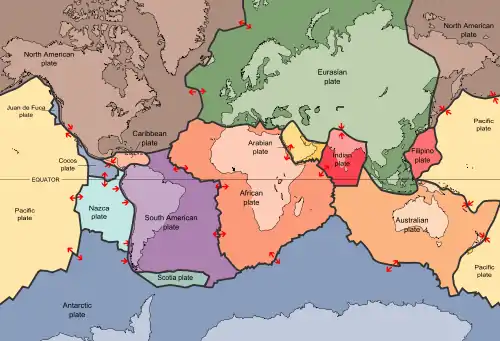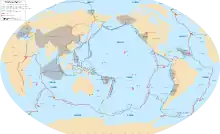Indo-Australian Plate
The Indo-Australian Plate is a major tectonic plate that includes the continent of Australia and surrounding ocean, and extends northwest to include the Indian subcontinent and adjacent waters. It was formed by the fusion of Indian and Australian plates approximately 43 million years ago.[1] The fusion happened when the mid-ocean ridge in the Indian Ocean, which separated the two plates, ceased spreading.[2]

Plate movements
The eastern part (Australia) is moving northward at the rate of 5.6 cm (2.2 in) per year while the western part (India) is moving only at the rate of 3.7 cm (1.5 in) per year due to the impediment of the Himalayas. This differential movement has resulted in the compression of the former plate near its centre at Sumatra and the division into the Indian and Australian Plates.[3][4]
A third plate, known as the Capricorn Plate, may also be separating off the western side of the Indian plate as part of the continued breakup of the Indo-Australian Plate.[5]
Separation
Recent studies, and evidence from seismic events such as the 2012 Indian Ocean earthquakes, suggest that the Indo-Australian Plate may have broken up into two or three separate plates due primarily to stresses induced by the collision of the Indo-Australian Plate with Eurasia along what later became the Himalayas,[6][7] and that the Indian Plate and Australian Plate have been separate since at least 3 million years ago.[8]
References
- "The Indo-Australian Plate". austhrutime.com.
- Keep, Myra; Schellart, Wouter P. (2012). "Introduction to the thematic issue on the evolution and dynamics of the Indo-Australian plate". Australian Journal of Earth Sciences. 59, 2012 (6: THEMATIC ISSUE — Evolution and dynamics of the Indo-Australian plate): 807–808. doi:10.1080/08120099.2012.708360. S2CID 128996831.
- "Earth cracking up under Indian Ocean". New Scientist. 26 September 2012. Retrieved 14 March 2018.
- Delescluse, Matthias; Chamot-Rooke, Nicolas; Cattin, Rodolphe; Fleitout, Luce; Trubienko, Olga; Vigny, Christophe (26 September 2012). "April 2012 intra-oceanic seismicity off Sumatra boosted by the Banda-Aceh megathrust". Nature. 490 (7419): 240–4. doi:10.1038/nature11520. PMID 23023134. S2CID 205230868.
- Siegel, Lee (26 September 2012). "Sumatra quake was part of crustal plate breakup: Study shows huge jolt measured 8.7, ripped at least 4 faults". Phys.Org. Retrieved 6 October 2012.
- "Press Release: An Earth Plate Is Breaking in Two". www.columbia.edu.
- R. R. Hillis, R. D. Müller. Evolution and Dynamics of the Australian Plate
- Stein, Seth; Sella, Giovanni; Okai, Emile A. (2002). "The January 26, 2001 Bhuj Earthquake and the Diffuse Western Boundary of the Indian Plate" (PDF). Plate Boundary Zones. Geodynamics Series. American Geophysical Union. pp. 243–254. doi:10.1029/GD030p0243. ISBN 9781118670446. Retrieved 26 December 2015.
